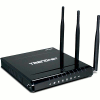- Qualcomm Launches Snapdragon 4 Gen 2 Mobile Platform
- AMD Launches Ryzen PRO 7000 Series Mobile & Desktop Platform
- Intel Launches Sleek Single-Slot Arc Pro A60 Workstation Graphics Card
- NVIDIA Announces Latest Ada Lovelace Additions: GeForce RTX 4060 Ti & RTX 4060
- Maxon Redshift With AMD Radeon GPU Rendering Support Now Available
TRENDnet TEW-633GR Wireless N Gigabit Router

Where routers are concerned, TRENDnet may not be the first name to come to mind, but their popularity is quickly growing. On our test-bench is a perfect example as to why that’s the case. If you are looking for a feature-rich N-based router for a reasonable price, the TEW-633GR is worth a look.
Page 3 – Software, Setup and Security
With any router you buy, software is included to help aid in setting up your router and customize it to fit your needs. Most walk you through encryption settings and help you get the most out of your router. Obviously all these steps can be achieved without this software but for the novice user, programs like these are quite necessary. Never the one’s to miss a step; TRENDnet has included just such software on the setup disk to help those of us who might not have the experience of others.
To install the software, simply place the CD in your drive tray and when the auto start comes up, click on the “Install Router.” You might notice that there is the option to install bonus software. This includes a McAfee anti-virus program and network magic. While we did not install either of these programs, those that either need them or are curious to try them out, this might help seal the deal when considering a router upgrade.
The best part about software setup aids like the one included with the 633GR is that they are mind numbingly easy. It’s rather difficult to miss a step when they grab your hand and walk you through each step. Below are a few screen grabs of the setup process.
When you first start, the router will ping the TRENDnet servers and see if there are any updates that are available before the setup process begins. After it decides if it needs an update or not, the setup home screen comes up allowing you to select your language of choice and gives you the option of installing the Network Magic trial software. Fortunately, you are not forced to install this software and can simply check a box declining the software setup.

From there, it checks for a connection. This is where the setup process ran amok. Regardless of what we had connected, it continued to detect multiple wired adapters. After exhausting all possibilities and without determining what the cause of the error was, we canceled out the setup process and set at it the old fashioned way, through the web interface. This conveniently brings us to our coverage of the UI. What a convenient segway.
By default, TRENDnet uses the IP address of 192.168.10.1 for its gateway. When you have your router powered on and your PC plugged into it, simply type this IP address in your web browser of choice and it will bring you to the log on page. The log on credentials for the 633GR happen to be the same as they were for the 631BRP: user name is admin and the password is blank. You have the ability to setup users as you see fit but for this review, we are sticking with the tried and true defaults.
Once in, the first screen we see is the “basic” screen. From here we can go through the setup process much like we would have done with the help of the setup disk had it not crapped out on us. You have the choice to setup your Internet connection as well as your wireless network too. If you just want to view your setup, you can view it by navigating to the network settings page.
If you understand how to type an IP address into your browser, and I would certainly hope you could, this is the method that I prefer far more than the setup disk. While the disk is convenient, if you plan on setting anything different than its default setting, you’re going to need to get to this UI anyway so you might as well just set the entire thing up from here while you’re at it. That’s just me though.
Moving onto the advanced tab, we see far more options available to play with. You can see in the following picture all of the different areas that you can change but we will touch on the most relevant. If you plan on running an FTP you can setup a virtual server on your machine.
For you gamers out there, you can open ports if needed or you can select from a long list of pre-programmed games. All that you need to do is select the game that you would like to setup and it will automatically fill in the TCP and UDP ports that need opening and setup the filters too. The only input needed from you is to assign which machine on your network you want to apply the settings for and with the help of a drop down menu; you can select any machine currently connected to your network. Thanks to DNS you are given the names of the PCs instead of the IP address. This helps greatly in avoiding confusion. You can even setup multiple gaming rules as well. How nice is that?
There is also the “StreamEngine” that is basically a QoS service. This sets up priority of service for one application or another. There is also an area that allows you to setup routing tables, you can institute parental controls that limit connection to the Internet for certain PCs on your network and you can even micro manage this by allowing outbound connections in only certain hours of the day, preventing P2P and gaming services and make a list of approved sites that the user is allowed to visit.
This is a great feature for parents looking to protect their children from questionable sites, or controlling parents looking to regulate every aspect of their children’s lives. I suppose that’s a matter of perspective really but the options are there if you want to use them.
There are also firewall options allowing you to enable SPI as well as setup NAT filtering. You can set up a PC as well to operate in the DMZ, allowing that PC to operate unrestricted. If you are looking to control the power of the antennas, you can do that too in the advanced wireless settings. If you’re looking to enable UPnP or set your wired port speeds, you can do that too in the advanced network tab.
In the Tools section, you can setup a password, adjust your routers internal clock, setup the system log files to send log information to another machine and setup the router to email you with log files alert messages and firmware updates. If you are looking to update your firmware because you got an email from your 633GR, you can do that here too. If you want to setup a dynamic DNS address as well. This is perfect if you host games on your own game server. Schedules can be adjusted here too for parental controls and firewall options.
To check the status of your network, you can navigate to the status page. From here you can view your currently connected machines, your IP information and view your log files.
If you have questions about any of these settings and what they do, the help menu is rather helpful and covers each and every option offered by the TRENDnet TEW-633GR.
If any of this looks familiar, you might remember seeing this almost identical option set in the D-Link DIR-655 review. These two companies clearly use the same user interface and as we discovered, these are not the only similarities between the 633GR and one of my personal favorite routers, the DIR-655.
|
|
Support our efforts! With ad revenue at an all-time low for written websites, we're relying more than ever on reader support to help us continue putting so much effort into this type of content. You can support us by becoming a Patron, or by using our Amazon shopping affiliate links listed through our articles. Thanks for your support!














